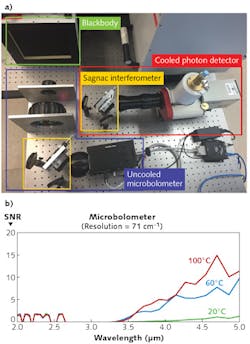Hyperspectral Imaging: Lightweight, simple, hyperspectral interferometer-bolometer detects gas species

Whether quantifying the amount of carbon dioxide (CO2), methane (CH4), or other gas species in our atmosphere or in other planetary atmospheres, or measuring the energy of wildfires towards making global biomass predictions, infrared (IR) imaging and sensing is invaluable for many scientific disciplines. And while many atmospheric gases and ignition events have strong mid-IR signatures from 3 to 5 μm, there is significantly less light available for detection compared to long-wave IR (LWIR) signals from 8 to 14 μm—not to mention that mid-IR detection often requires bulky, power-hungry cooling equipment to boost signal-to-noise ratio (SNR).
Considering these disadvantages, and recognizing that light throughput is significantly better for interferometers compared to dispersive spectrometers, researchers at the University of Hawaii (Honolulu, HI) have developed an interferometer-based spectral imaging system that uses uncooled microbolometers rather than classic cooled photon-detecting arrays paired with a spectrometer.1 This miniaturized IR detector of atmospheric species (MIDAS) is a low-power-consumption, lightweight hyperspectral imaging alternative to conventional spectroscopy.
The MIDAS touch
Basically, MIDAS consists of an uncooled microbolometer (37.5 μm pixel pitch, 30 Hz, 320 × 240, 2.5 W) married to a Sagnac interferometer (see figure). The beamsplitter and two mirrors of the interferometer break the input light into its individual frequencies and generate an interference pattern that is processed using standard Fourier-transform algorithms to derive a calibrated spectral trace for each element of the scene. The setup also includes an indium antimonide (InSb) cooled photon detector with 30 μm pixel pitch run at 30 Hz with a 320 × 256 array and 12 W output.
The researchers at the University of Hawaii have previously demonstrated that uncooled microbolometers coupled with a Sagnac interferometer can provide adequate SNR in the LWIR. The goal of MIDAS is to determine if this holds true in the MWIR by comparing MIDAS to the InSb cooled photon detector in the same Sagnac interferometer configuration.
Comparisons of SNR, noise-equivalent different temperature (NEdt), noise-equivalent spectral radiance, spectral response, and gas cells filled with known gas concentrations help determine whether the increased light-gathering ability of the interferometer will allow uncooled microbolometers to be used in the MWIR. Current SNR measurements indicate that MIDAS is best used for high-temperature targets. Further analysis is underway to determine if these measurements can be improved.
"Here at the University of Hawaii, we are working to precisely define the performance of uncooled microbolometers for spectroscopic detectors," says Casey I. Honniball, graduate research assistant. "We are looking at a variety of Earth and planetary science applications like gas detection from space using high-temperature target, including fires, gas flares, volcanoes, and lava flows on Earth as well as on other bodies in the solar system. Instruments like MIDAS are attractive candidates for IR imaging spectroscopy on small satellites due to their lightweight and low power requirements."
REFERENCE
1. C. I. Honniball et al., SPIE Newsroom online, doi:10.1117/2.1201607.006630 (Aug. 9, 2016); see http://bit.ly/2eJPWLx.

Gail Overton | Senior Editor (2004-2020)
Gail has more than 30 years of engineering, marketing, product management, and editorial experience in the photonics and optical communications industry. Before joining the staff at Laser Focus World in 2004, she held many product management and product marketing roles in the fiber-optics industry, most notably at Hughes (El Segundo, CA), GTE Labs (Waltham, MA), Corning (Corning, NY), Photon Kinetics (Beaverton, OR), and Newport Corporation (Irvine, CA). During her marketing career, Gail published articles in WDM Solutions and Sensors magazine and traveled internationally to conduct product and sales training. Gail received her BS degree in physics, with an emphasis in optics, from San Diego State University in San Diego, CA in May 1986.